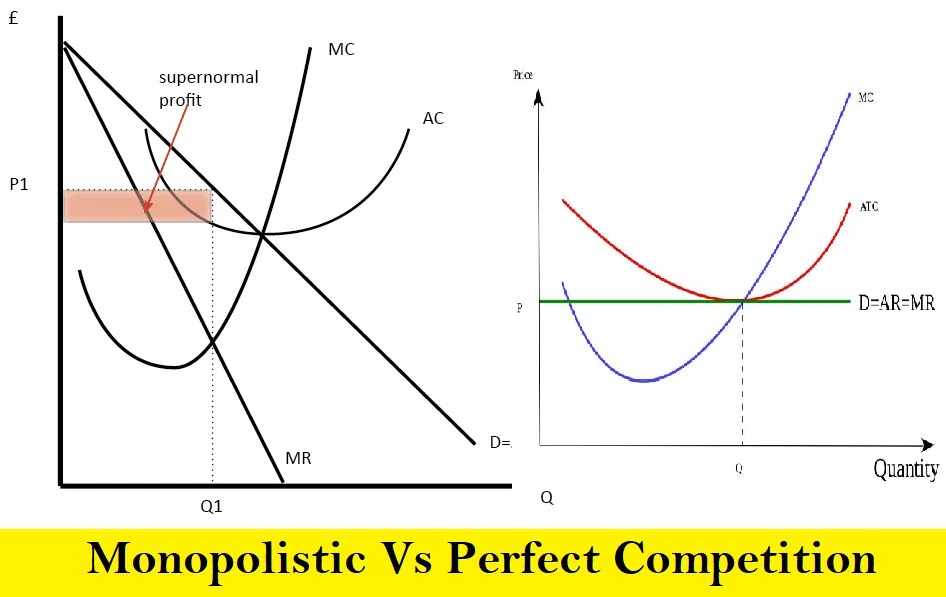
Monopolistic and perfect competition are two economic models that illustrate the market interactions of producers, consumers, and other firms. Monopolistic competition is defined as a market with many competitors with unique products or services competing for customers. Perfectly competitive markets have so little product differentiation that anyone can sell their goods to any customer at the same price without affecting supply. These two different models differ in 15 ways! To see which model your company most closely resembles, read below.
Monopolistic Competition Vs Perfect Competition Graph
What Are The Differences Between Monopolistic Competition and Perfect Competition?
| Factor | Monopolistic Competition | Perfect Competition |
| 1. Uniqueness of product/services | Monopolistic competition has a large number of firms and products, but each product is unique. There is an abundance of choices in monopolistic competition, with every good being utterly distinct from its competitor, making it difficult for customers to substitute one brand for another. The variety available in monopolistic markets makes them more dynamic than perfectly competitive markets, which tend to be less responsive to changes in supply and demand conditions. | Perfect competition has only a few firms, and each product is similar. It may have many different products, but the various goods are not significantly differentiated in terms of features or quality. So, it’s easy to switch brands without losing anything important. |
| 2. Stability of competition | Competition can also vary across periods, given that monopolistically competitive market structures evolve as new companies enter into the marketplace or existing ones leave depending on their profitability. | Perfectly competitive markets are relatively stable over time, making it difficult for new firms to enter the market or existing ones to leave. |
| 3. Ability to make supernormal Profits | In monopolistic competition, firms can make supernormal profits in the long run. | n perfect competition, no firm makes a supernormal profit over the long term due to cutthroat competitive pressures that drive prices down and cause losses for all but one of them. |
| 4. Model type | Monopolistic competition is a better model for describing the market structure of modern economies. | Perfectly competitive markets often describe simple commodity markets with little product differentiation and only one or two producers in each industry. This market structure seems to work best with simpler, more rudimentary economic models. |
| 5. Need for advertisement | Companies operating under monopolistic competition tend to produce differentiated products, so they must advertise their goods as superior to others. | Companies practicing perfect competition have less need to advertise their goods since everyone produces standardized goods. |
| 6. Amount of goods produced | Monopolistic competition is more likely to produce sub-optimal amounts of a given product or service because it considers more than just changes in supply and demand when deciding how much of any given product or service should be brought to market. | Perfectly competitive markets tend to reach the optimal amount of production for any good because they are most sensitive to changes in supply and demand. |
| 7. Market entry | In monopolistic competition, a few large competitors make it difficult to enter the industry. | Perfectly competitive markets make it easy for new firms to join existing industries since they can produce and sell goods much like any other company around them. There is no need for special conditions like exclusive licenses or permits to get your foot in the door when starting your own business. |
| 8. Price discrimination | In monopolistic competition, firms can charge different prices based on how much of a product or service is purchased and who it’s being sold to, especially since companies tend to set their prices in this type of structure. | In a perfectly competitive market, all customers pay the same price. |
| 9. Number of Suppliers | Monopolistic competition, by contrast, will have a relatively small number of suppliers since it excludes new competitors from entering the market once one or two brands become established. | Perfect competition has an infinite number of suppliers. |
| 10. Economic profit | Some monopolistically competitive markets may experience positive economic profits due to barriers preventing new competitors from entering existing markets. | In perfect competition, firms will make zero economic profit in the long run since price equals marginal cost. |
| 11. Number of Decisions Firms Need To Make Daily | Monopolistic competitors will have many decisions to make each day, mainly choosing who they do business with. The latter implies finding suppliers that offer fair rates for quality products or services plus sticking with contracts even if that entails selling less than usual or cutting back on staff. | Firms in perfect competition only have one decision to make every day since they produce the same product at a profit-maximizing output level and charge the price dictated by market conditions. |
| 12. Degree of Competition | The monopolistic competition will have a low degree since it excludes new competitors from entering the market. | Perfect competition has a high degree of competition. |
| 13. Degree of Control | Monopolistic competitors can exercise some degree of control since they can set their prices based on factors like costs, availability of other suppliers or substitutes, the elasticity of demand for its goods or services. Also, it includes how much business it does with anybody else in any given industry sector. | Firms practicing perfect competition have no control over the market price because it’s determined by demand and supply. |
| 14. Number Of Buyers Per Firm | Monopolistic competitors will have few buyers, mainly because they don’t need them to remain viable businesses since they can set their prices instead. Consequently, producers may only sell goods or services directly through retailers who buy from distributors and consumers with no middlemen involved unless law. The latter includes antitrust legislation preventing monopolies and unfair market practices, which has given rise to so-called supply chain management today. | Perfectly competitive markets will typically have many buyers per firm because each seller is so tiny relative to total industry output. There is no way they could influence the market price even if they wanted to do so, and it implies that firms are also powerless when dealing with larger companies that are more likely to impact prices. |
| 15. Degree of Specialization | Monopolistic competitors will have a high degree of specialization due mainly to choosing who they do business with and not having any reason to sell their goods or services in bulk quantities. Since it’s unlikely that anyone would buy more than they need. | Perfectly competitive markets will typically have zero degrees of specialization because the firms within one sector sell a similar product. |
In summary of the above, Monopolistic competition can be viewed as a cross between perfect competition and pure monopoly. Consequently, it’s somewhere in the middle when compared to each of these market structures with its own unique set of characteristics different from either one. The latter is what business owners need to understand if they want to comprehend what it takes for their businesses moving forward.




